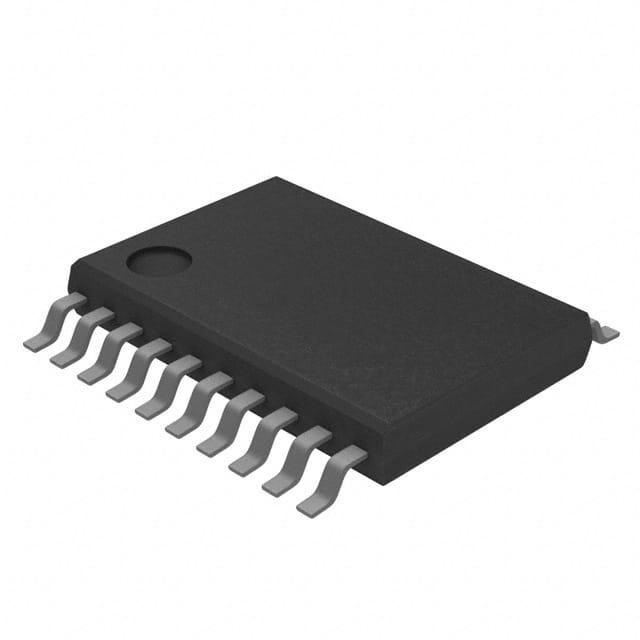Szczegóły produktu można znaleźć w specyfikacjach.

SN74HCT374PW
Product Overview
Category
SN74HCT374PW belongs to the category of integrated circuits (ICs).
Use
It is commonly used as a flip-flop latch in digital electronic circuits.
Characteristics
- High-speed operation
- Low power consumption
- Compatibility with TTL inputs
- Wide operating voltage range
- Schmitt-trigger action on all inputs
- Balanced propagation delays
Package
SN74HCT374PW is available in a TSSOP (Thin Shrink Small Outline Package) package.
Essence
The essence of SN74HCT374PW lies in its ability to store and transfer data in digital systems.
Packaging/Quantity
SN74HCT374PW is typically packaged in reels, with 2500 units per reel.
Specifications
- Supply Voltage: 2V to 6V
- Input Voltage: 0V to VCC
- Output Voltage: 0V to VCC
- Operating Temperature Range: -40°C to +85°C
- Maximum Clock Frequency: 25 MHz
- Number of Flip-Flops: 8
Detailed Pin Configuration
- GND (Ground)
- D0 (Data Input 0)
- D1 (Data Input 1)
- D2 (Data Input 2)
- D3 (Data Input 3)
- D4 (Data Input 4)
- D5 (Data Input 5)
- D6 (Data Input 6)
- D7 (Data Input 7)
- MR (Master Reset)
- CP (Clock Pulse)
- OE (Output Enable)
- Q0 (Flip-Flop Output 0)
- Q1 (Flip-Flop Output 1)
- Q2 (Flip-Flop Output 2)
- Q3 (Flip-Flop Output 3)
- Q4 (Flip-Flop Output 4)
- Q5 (Flip-Flop Output 5)
- Q6 (Flip-Flop Output 6)
- Q7 (Flip-Flop Output 7)
- VCC (Positive Power Supply)
Functional Features
- Data storage and transfer: SN74HCT374PW can store data on its flip-flops and transfer it to the output pins.
- Master reset: The MR pin allows resetting all flip-flops simultaneously.
- Clock pulse: The CP pin triggers the transfer of data from input to output.
- Output enable: The OE pin enables or disables the output.
Advantages and Disadvantages
Advantages
- High-speed operation allows for efficient data processing.
- Low power consumption reduces energy requirements.
- Compatibility with TTL inputs ensures compatibility with existing systems.
- Wide operating voltage range provides flexibility in various applications.
- Schmitt-trigger action on all inputs enhances noise immunity.
- Balanced propagation delays ensure accurate timing.
Disadvantages
- Limited number of flip-flops may restrict the complexity of circuits that can be implemented.
- TSSOP package may require careful handling during assembly.
Working Principles
SN74HCT374PW operates based on the principles of flip-flops and clocked sequential logic. When a clock pulse is received, the data present at the input pins is transferred to the corresponding output pins. The master reset pin allows clearing all flip-flops simultaneously, while the output enable pin controls the availability of output data.
Detailed Application Field Plans
SN74HCT374PW finds applications in various digital electronic systems, including but not limited to: - Microcontrollers - Data storage devices - Communication systems - Industrial automation - Automotive electronics
Detailed and Complete Alternative Models
Some alternative models to SN74HCT374PW that serve similar functions include: - 74HC374 - CD74HCT374E - MC74HCT374AN - SN54HCT374J
These models offer comparable features and can be used as substitutes in different applications.
In conclusion, SN74HCT374PW is a versatile integrated circuit commonly used as a flip-flop latch in digital electronic circuits. Its high-speed operation, low power consumption, and compatibility with TTL inputs make it suitable for various applications. However, its limited number of flip-flops and specific package type should be considered when selecting alternative models.
Wymień 10 typowych pytań i odpowiedzi związanych z zastosowaniem SN74HCT374PW w rozwiązaniach technicznych
Sure! Here are 10 common questions and answers related to the application of SN74HCT374PW:
Q: What is the SN74HCT374PW? A: The SN74HCT374PW is a high-speed octal D-type flip-flop with 3-state outputs, commonly used in digital logic circuits.
Q: What is the maximum operating voltage for the SN74HCT374PW? A: The SN74HCT374PW has a maximum operating voltage of 5.5V.
Q: How many flip-flops are there in the SN74HCT374PW? A: The SN74HCT374PW contains 8 flip-flops, making it an octal flip-flop.
Q: What is the output current capability of the SN74HCT374PW? A: The SN74HCT374PW has a typical output current capability of ±6mA.
Q: Can the SN74HCT374PW be used in both parallel and serial data transfer applications? A: Yes, the SN74HCT374PW can be used in both parallel and serial data transfer applications.
Q: What is the propagation delay of the SN74HCT374PW? A: The propagation delay of the SN74HCT374PW is typically around 15ns.
Q: Does the SN74HCT374PW have internal pull-up or pull-down resistors? A: No, the SN74HCT374PW does not have internal pull-up or pull-down resistors.
Q: Can the SN74HCT374PW operate at high temperatures? A: Yes, the SN74HCT374PW has a wide operating temperature range of -40°C to 85°C.
Q: What is the power supply voltage range for the SN74HCT374PW? A: The power supply voltage range for the SN74HCT374PW is typically between 4.5V and 5.5V.
Q: Can the SN74HCT374PW be cascaded to increase the number of flip-flops? A: Yes, multiple SN74HCT374PW chips can be cascaded together to increase the number of flip-flops in a circuit.
Please note that these answers are general and may vary depending on the specific application and datasheet of the SN74HCT374PW.

